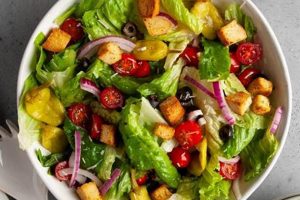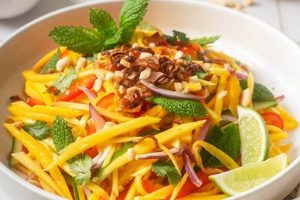Fresh spring roll wrappers encasing a vibrant mix of vegetables, herbs, and often a protein source like shrimp or tofu, served with a flavorful dipping sauce, characterize this culinary creation. A typical preparation might involve julienned carrots, cucumbers, bell peppers, lettuce, rice noodles, and fresh mint and cilantro, all wrapped in a translucent rice paper wrapper. Peanut, hoisin, or fish sauce-based dips provide a complementary savory element.
These rolls offer a refreshing and healthy meal or snack option. The abundance of raw vegetables provides vitamins, minerals, and fiber. Their customizable nature allows for diverse flavor profiles and caters to various dietary restrictions, including vegetarian, vegan, and gluten-free diets. Historically, fresh spring rolls have roots in Southeast Asian cuisine, particularly Vietnamese and Thai culinary traditions, where they are often enjoyed as street food or appetizers.
This article will delve into variations of this versatile dish, exploring different ingredient combinations, wrapper types, and dipping sauces. Guidance on preparation techniques, including proper handling of rice paper wrappers and tips for achieving aesthetically pleasing rolls, will also be provided.
Tips for Perfect Spring Rolls
Achieving well-constructed, flavorful spring rolls involves attention to detail and a few key techniques. The following tips offer guidance for optimal results.
Tip 1: Prepare Ingredients in Advance: Pre-cutting vegetables and other fillings into thin, uniform strips facilitates efficient assembly. This ensures even distribution of ingredients within each roll and prevents overfilling.
Tip 2: Proper Rice Paper Handling: Rice paper wrappers require brief soaking in warm water to achieve pliability. Over-soaking results in a sticky, difficult-to-manage wrapper. A shallow dish of warm water allows for controlled hydration.
Tip 3: Avoid Overfilling: Overfilling makes rolling challenging and can lead to tearing. A moderate amount of filling allows for tight, secure rolls.
Tip 4: Strategic Ingredient Placement: Placing visually appealing ingredients near the translucent exterior enhances presentation. Consider the color and texture of ingredients when arranging them on the wrapper.
Tip 5: Tight Rolling Technique: A firm, even rolling technique, similar to wrapping a burrito, creates compact, aesthetically pleasing rolls. Start by folding the sides of the wrapper inward, then tightly roll from the bottom up.
Tip 6: Dipping Sauce Selection: Complementary dipping sauces enhance the overall flavor profile. Peanut, hoisin, and fish sauce-based options provide contrasting savory notes.
Tip 7: Serving and Storage: Serve spring rolls immediately for optimal texture. If storing, cover tightly and refrigerate to prevent drying. Avoid stacking, which can cause sticking and damage the delicate wrappers.
Following these guidelines ensures the creation of delicious and visually appealing spring rolls, enhancing culinary enjoyment.
By incorporating these techniques, one can confidently create spring rolls that showcase fresh ingredients and vibrant flavors.
1. Fresh Ingredients
The emphasis on fresh ingredients is integral to the essence of salad spring rolls. These rolls showcase the vibrancy and natural flavors of raw or lightly cooked vegetables and herbs. Quality ingredients translate directly to superior flavor and textural complexity. A spring roll comprised of wilted lettuce or mealy tomatoes compromises the intended refreshing and crisp experience. Conversely, a roll bursting with crisp cucumbers, fragrant mint, and succulent shrimp exemplifies the potential of fresh, high-quality components. The delicate rice paper wrapper serves as a neutral canvas, allowing the fresh ingredients to take center stage.
Utilizing fresh ingredients extends beyond mere flavor enhancement. It contributes significantly to the nutritional value of the dish. Vitamins, minerals, and antioxidants are preserved in their most potent forms when consumed raw or minimally processed. This nutritional density aligns with the health-conscious nature often associated with this culinary creation. Furthermore, the selection of fresh, seasonal produce can elevate the overall culinary experience. Locally sourced ingredients, at their peak ripeness, offer unparalleled flavor and contribute to sustainable culinary practices.
Prioritizing fresh, high-quality ingredients is paramount to a successful salad spring roll experience. This commitment ensures optimal flavor, nutritional value, and textural appeal. The interplay of fresh components within the delicate rice paper wrapper creates a dish that is both light and satisfying. Careful selection of ingredients elevates the dish from a simple snack to a sophisticated culinary expression.
2. Proper Rice Paper
The selection and handling of rice paper wrappers are critical to the success of a salad spring roll recipe. Rice paper provides the structural foundation of the roll, acting as a delicate yet sturdy vessel for the fresh ingredients. Its properties influence not only the roll’s structural integrity but also its textural appeal and overall aesthetic. Understanding the nuances of rice paper selection and preparation is essential for achieving desirable results.
- Wrapper Thickness:
Rice paper wrappers are available in varying thicknesses, each suited to different culinary applications. Thicker wrappers offer greater durability and are less prone to tearing, making them ideal for rolls containing heavier fillings or for those new to spring roll assembly. Thinner wrappers provide a more delicate texture and allow the vibrant colors of the ingredients to shine through. Choosing the appropriate thickness ensures ease of handling and contributes to the overall aesthetic of the finished product.
- Hydration Technique:
Proper hydration is crucial for achieving the ideal pliability of rice paper. Over-soaking results in a sticky, difficult-to-manage wrapper, while under-soaking leads to cracking and tearing during rolling. Briefly submerging the wrapper in warm water until pliable is the recommended method. The optimal hydration time varies depending on the wrapper’s thickness and ambient temperature. Mastering this technique ensures a smooth, even texture and contributes to the structural integrity of the roll.
- Size and Shape:
Rice paper wrappers are available in various sizes and shapes, from small rounds ideal for appetizers to larger squares suitable for more substantial rolls. The choice of size and shape depends on the intended presentation and the quantity of filling. Uniformity in size and shape contributes to a visually appealing final product.
- Ingredient Compatibility:
The delicate nature of rice paper requires careful consideration of ingredient compatibility. Ingredients with sharp edges or rough textures can easily puncture the wrapper. Proper preparation of fillings, such as julienning vegetables into thin, uniform strips, minimizes the risk of tearing. Understanding the interaction between the wrapper and the filling ensures a structurally sound and aesthetically pleasing final product.
These facets of rice paper selection and handling directly impact the overall success of a salad spring roll recipe. Choosing the appropriate wrapper thickness, mastering the hydration technique, selecting the correct size and shape, and ensuring ingredient compatibility contribute to both the structural integrity and aesthetic appeal of the finished dish. Attention to these details elevates the spring roll from a simple assembly of ingredients to a carefully crafted culinary creation.
3. Balanced Filling
A balanced filling is paramount in a successful salad spring roll recipe. Balance encompasses several key aspects: texture, flavor, and color. Textural diversity, achieved through a combination of crisp vegetables, soft herbs, and perhaps a protein element like cooked shrimp or tofu, creates a more engaging culinary experience. A monotonous texture, such as an all-vegetable filling without the addition of herbs or protein, can result in a less satisfying product. Flavor balance, achieved through the interplay of sweet, savory, spicy, and sour notes, is equally crucial. A filling dominated by a single flavor profile can become overwhelming. The incorporation of complementary flavors, such as the sweetness of bell peppers paired with the pungent bite of cilantro and the savory richness of shrimp, results in a more complex and nuanced flavor profile. Color variation contributes to visual appeal. A vibrant mix of colorful vegetables, like red bell peppers, green lettuce, orange carrots, and purple cabbage, enhances the aesthetic presentation and stimulates appetite. A monochromatic filling, while potentially flavorful, can lack visual interest.
Consider a spring roll filled solely with shredded lettuce and rice noodles. While refreshing, the texture might be perceived as one-dimensional. The addition of julienned carrots and cucumbers introduces a contrasting crispness, while the inclusion of fresh mint and cilantro provides a softer, aromatic counterpoint. Further incorporating grilled shrimp or tofu introduces a savory element and a denser texture. From a flavor perspective, a filling dominated by the peppery flavor of arugula might benefit from the sweetness of mango or the tanginess of pickled carrots. The incorporation of a flavorful dipping sauce, like a peanut or hoisin-based sauce, adds another layer of complexity and complements the filling’s inherent flavors. Visually, a spring roll composed primarily of pale green ingredients might appear less appealing than one showcasing a vibrant array of colors.
Achieving a balanced filling elevates the salad spring roll from a simple assembly of ingredients to a carefully orchestrated culinary experience. Consideration of textural contrasts, flavor complexities, and color variations enhances both the sensory experience and the nutritional value. The interplay of these elements within the delicate rice paper wrapper creates a dish that is not only visually appealing but also nutritionally balanced and texturally satisfying. Mastery of this principle allows for the creation of spring rolls that are as delightful to the palate as they are to the eye.
4. Flavorful Dipping Sauce
The dipping sauce plays a crucial role in the overall sensory experience of salad spring rolls. While the filling provides a foundation of fresh flavors and textures, the dipping sauce acts as a flavor enhancer and unifying element. It provides a contrasting or complementary flavor profile that elevates the inherent flavors of the filling ingredients. A bland or poorly conceived dipping sauce can detract from the freshness of the roll, while a well-crafted sauce amplifies the culinary experience. Consider the interplay between a vibrant filling of fresh herbs, crisp vegetables, and succulent shrimp, and a rich, savory peanut sauce. The sauce’s nutty, umami notes complement the fresh, herbaceous flavors of the filling, creating a harmonious and balanced flavor profile. Conversely, a watery, flavorless dipping sauce would diminish the impact of the carefully selected ingredients.
Several factors contribute to a successful dipping sauce. Texture is a key consideration. A thick, creamy peanut sauce clings to the delicate rice paper wrapper and provides a satisfying mouthfeel, while a thin, watery sauce might lack the desired textural contrast. Flavor balance is essential. A sauce that is overly sweet, salty, sour, or spicy can overwhelm the subtle flavors of the filling. A well-balanced sauce harmonizes with the filling, enhancing rather than masking its inherent flavors. Consider a classic Vietnamese dipping sauce, nc chm. Its balanced combination of sweet, sour, salty, and spicy notes, derived from fish sauce, lime juice, sugar, and chili, provides a complex yet harmonious counterpoint to the fresh ingredients of a spring roll. This balance allows the individual flavors of the filling to shine through while simultaneously adding another layer of flavor complexity.
Understanding the crucial role of the dipping sauce in a salad spring roll recipe is essential for achieving a truly satisfying culinary experience. It is not merely an accompaniment but an integral component that elevates the dish. A well-crafted dipping sauce, with its balanced flavors and complementary textures, enhances the inherent flavors of the fresh ingredients, creating a harmonious and memorable culinary experience. Careful consideration of the dipping sauce ensures that the final product is not only visually appealing but also delivers a complex and balanced flavor profile.
5. Tight Rolling Technique
A tight rolling technique is fundamental to a successful salad spring roll recipe. Structural integrity, aesthetic presentation, and even flavor distribution depend on proper execution. A tightly rolled spring roll holds its shape, preventing unraveling during handling and consumption. This structural soundness allows for neat slicing and serving, contributing to a more refined presentation. Loosely rolled spring rolls, conversely, tend to fall apart, resulting in a messy and less appealing dish. Furthermore, a tight roll ensures even distribution of the filling, providing a consistent flavor profile with each bite. A loose roll may have pockets of isolated ingredients, leading to an uneven flavor experience.
Consider the analogy of constructing a burrito. A tightly packed burrito maintains its cylindrical form, while a loosely packed one is prone to spillage and structural collapse. Similarly, a tight spring roll, achieved through a firm, even rolling motion, holds its shape and ensures the ingredients remain securely contained within the delicate rice paper wrapper. This technique also prevents the wrapper from becoming soggy due to excessive contact with the filling’s moisture. Imagine a spring roll filled with juicy ingredients like shredded carrots and mango. A tight roll minimizes direct contact between the wrapper and these moist ingredients, preserving the wrapper’s delicate texture. A loose roll, on the other hand, allows the moisture to seep into the wrapper, resulting in a soggy, less palatable experience.
Mastery of the tight rolling technique elevates the salad spring roll from a simple assembly of ingredients to a carefully crafted culinary creation. It contributes not only to the structural integrity and aesthetic presentation of the roll but also enhances the overall sensory experience. A tight roll ensures even flavor distribution and prevents the wrapper from becoming soggy, preserving the intended textural contrast between the delicate wrapper and the fresh, crisp filling. This seemingly simple technique is crucial for achieving a visually appealing and palate-pleasing final product.
6. Aesthetic Presentation
Aesthetic presentation plays a significant role in the overall appeal of a salad spring roll recipe. Visual appeal enhances the dining experience, stimulating appetite and creating a sense of anticipation. Consider the impact of color. Vibrant hues from ingredients like carrots, bell peppers, and fresh herbs create a visually engaging dish, while a monochromatic presentation can appear less enticing. The arrangement of ingredients within the translucent rice paper wrapper also contributes to the aesthetic. Strategically placing visually appealing elements, like shrimp or colorful vegetables, near the exterior enhances the roll’s attractiveness. Uniformity in size and shape further contributes to a polished presentation. A plate of unevenly sized rolls appears less refined than a presentation of uniformly constructed rolls.
The impact of aesthetic presentation extends beyond mere visual appeal. It influences perception of flavor and quality. A well-presented dish suggests attention to detail and culinary expertise, creating a positive impression even before the first bite. Consider the difference between a haphazardly assembled spring roll, with ingredients spilling out, and a tightly rolled, neatly arranged spring roll. The latter conveys a sense of care and precision, enhancing the perceived value of the dish. This effect is particularly relevant in culinary settings where presentation is paramount, such as restaurants or catered events. However, even in casual dining, the visual appeal of a dish contributes significantly to enjoyment.
In the context of a salad spring roll recipe, aesthetic presentation elevates the dish from a simple assembly of ingredients to a visually captivating culinary creation. Attention to color, arrangement, and uniformity enhances the dining experience, stimulating appetite and creating a sense of anticipation. While flavor and texture remain crucial components, visual appeal plays a significant role in the overall perception and enjoyment of the dish. This understanding allows for a more holistic approach to recipe development, where both culinary technique and aesthetic considerations contribute to a more satisfying and memorable dining experience.
Frequently Asked Questions
This section addresses common inquiries regarding the preparation and enjoyment of salad spring rolls.
Question 1: Can spring roll wrappers be made from scratch?
While commercially produced wrappers offer convenience, homemade versions are possible, albeit more time-consuming. Recipes typically involve rice flour, tapioca starch, and water, requiring specialized equipment and technique.
Question 2: What are suitable alternatives to rice noodles in the filling?
Vermicelli noodles, kelp noodles, or thinly sliced vegetables like zucchini or daikon radish offer alternatives to traditional rice noodles, catering to various dietary preferences.
Question 3: How can one prevent spring roll wrappers from sticking together?
Placing a slightly dampened cloth or parchment paper between individual wrappers after soaking prevents sticking and facilitates easier handling during assembly.
Question 4: What are the best storage practices for prepared spring rolls?
Refrigeration in an airtight container lined with a damp paper towel helps maintain freshness. Consumption within 24 hours is recommended for optimal texture and flavor.
Question 5: Are there gluten-free options for dipping sauces?
Many traditional dipping sauces, such as those based on fish sauce, rice vinegar, and tamari, are naturally gluten-free. Ensure commercially produced sauces are certified gluten-free when necessary.
Question 6: How can one adapt the recipe for vegan diets?
Substituting tofu or tempeh for shrimp and ensuring all sauces and ingredients are plant-based readily adapts this versatile dish for vegan consumption.
Addressing these common inquiries clarifies potential challenges and provides practical solutions, ensuring a successful and enjoyable culinary experience.
The following section will explore popular variations on the classic salad spring roll recipe, showcasing diverse culinary influences and ingredient combinations.
Conclusion
Exploration of salad spring roll recipes reveals a dish adaptable to various culinary traditions and dietary preferences. Emphasis on fresh, high-quality ingredients, proper rice paper handling, balanced fillings, flavorful dipping sauces, tight rolling techniques, and aesthetic presentation contributes to a successful outcome. From ingredient selection to final presentation, attention to detail elevates this seemingly simple dish to a culinary art form.
Culinary exploration extends beyond the provided guidelines. Experimentation with diverse ingredients, flavors, and cultural adaptations unlocks further culinary potential. This adaptable recipe provides a foundation for culinary creativity, encouraging exploration and personalization within the established framework. The potential for innovation within this culinary tradition remains vast.






